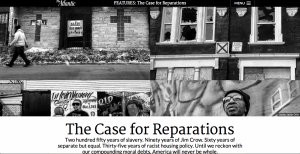I’ve just discovered a gem on Netflix. For a limited time, the epic Ken Burns series “The Civil War” is streaming in its entirety—all nine “Ken Burns effect” episodes of daguerreotype goodness. Even “Orange is the New Black” will have to go on hiatus for me to soak in the uninterrupted hours of PBS history bliss.
just discovered a gem on Netflix. For a limited time, the epic Ken Burns series “The Civil War” is streaming in its entirety—all nine “Ken Burns effect” episodes of daguerreotype goodness. Even “Orange is the New Black” will have to go on hiatus for me to soak in the uninterrupted hours of PBS history bliss.
So I recently pressed play to the tune of tranquil narration:
“…in 1861, most of the nation’s 31 million people lived peaceably on farms and in small towns…”
PAUSE.
On face value, this is a factual statement, combined with the infamous pan across black and white images of 1861 pastoral America.
Unfortunately I can’t keep watching.
For me, this assertion epitomizes the glaring historical inaccuracy that saturates the United States and perpetuates a culture of inequality and racism that has very real life threatening consequences on American minorities.
In 1861 (estimated from 1860 census figures), the United States did indeed have 31 million people, and 4 million of those people were slaves. A life of slavery, by definition, cannot reasonably be referred to as peaceable; it is a life of violence, terror and dehumanization. Nor can people held as slaves be lumped into the peaceable lives of farms and small towns, as they enjoyed none of the private or civic benefits of such economic and social structures. These figures furthermore wholly omit the tens of thousands of Native Americans whose existence, first obliterated, has been largely ignored to this day.
This kind of benign blanket statement is exceptionally dangerous. It perpetuates a myth in which we are able to dismiss the violent foundations of our society as irrelevant to our daily lives, when in fact the history and cycles of violence and subjugation continue to plague modern generations.
 You don’t have to take my word for it. Ta-Hehisi Coates’ recent should-be-required-reading Atlantic piece “The Case for Reparations,” breaks down in very plain English exactly how slavery and white supremacy has real economic and social impact on black Americans in 2014. Reparations, while monetarily justified, are really about “full acceptance of our collective biography and its consequences.”
You don’t have to take my word for it. Ta-Hehisi Coates’ recent should-be-required-reading Atlantic piece “The Case for Reparations,” breaks down in very plain English exactly how slavery and white supremacy has real economic and social impact on black Americans in 2014. Reparations, while monetarily justified, are really about “full acceptance of our collective biography and its consequences.”
The way we write our history matters. It sets the framework for our understanding of the past and the present. It creates a reality by which we judge our everyday experiences. When we write a history that omits the violence of slavery, even in passing, we are carrying on its legacy.
As documentary filmmakers we weave stories that create a version of reality. This reality frames the reactions, conclusions and memories of our audiences. It’s a colossal responsibility that includes the need to reeducate ourselves about myths and prejudices that are not only surviving but thriving.
This essay is not an indictment of Ken Burns, a filmmaker for whom I have the greatest respect and admiration and who has contributed to and helped paved the way for independent and creative storytelling.
But this is a call to action.
What if Ken Burns rewrote the narration for “The Civil War” in which the truth about our history of violence is front and center—a history of violence that is not about war or the Union or secession, or even abolition, but about how we treat people who are not white.
“To celebrate freedom and democracy while forgetting America’s origins in a slavery economy is patriotism à la carte.” Ta-Hehisi Coates
Re-writing “The Civil War” could change the way future generations remember U.S. history. The notoriety of this celebrated documentary series demonstrates that we as documentary filmmakers have the power to write history. What will you choose to do with it?
JOIN THE CONVERSATION on Facebook and Twitter using #REWRITE
